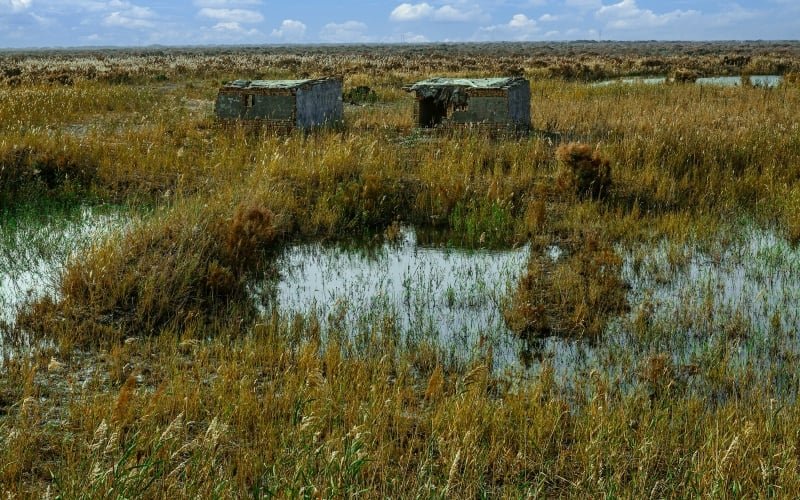

Nevada’s growing reliance on groundwater for irrigation and drinking water has led to significant declines in thousands of wells across the state, according to a recent study.
The study, published in Hydrological Process, analyzed data from about 6,500 wells across Nevada and found that about 40% had significant declines over the last three decades amid intensifying drought and rising water demand – a decline that is expected to put groundwater dependent ecosystems in the state at serious risk.
“That was a little surprising, we didn’t realize it was to that extent,” said Laurel Saito, water strategy director for The Nature Conservancy in Nevada and lead author of the study.
Only about 15% of wells analyzed had increasing water level trends over that same time period.
In Nevada about half of the state’s counties rely on groundwater for more than 80% of their water supply, according to the U.S. Geological Survey. The Nevada Division of Water Resources estimates that about 20% of Nevada’s groundwater basins are also being overpumped, meaning more groundwater is extracted than returned each year.
That overuse of groundwater can create a major issue for Nevada’s groundwater-dependent springs, wetlands and riparian habitats which sustain rare plants and wildlife in the state. There are 242 wetland-dependent species recorded by Nevada Division of Natural Heritage – 143 of which can only be found in Nevada.
Researchers warned that declining groundwater could eliminate entire ecosystems and harm struggling species — as seen with the only fish native to Pahrump Valley, the Pahrump poolfish. In the 1970’s, the Pahrump poolfish was removed from its native habitat in Manse Spring when it became clear the spring would go dry due to groundwater pumping.
Using public data, researchers created a statewide database of groundwater-dependent ecosystems which revealed that at least 40% of them were in basins that had more water rights committed than estimated available groundwater.
Overall, about 20% of Nevada’s groundwater-dependent habitats were at moderate to high risk for groundwater pumping stress due to excessive groundwater pumping. In habitats that relied on shallow groundwater, like wetlands and playas, about 70% of them were at risk from groundwater pumping due to their location near wells.
A large portion of groundwater-dependent plants, about 40%, were less than half a mile away from wells with significantly declining groundwater.
“Generally, where you have shallow groundwater, somebody starts pumping there. It is going to affect groundwater-dependent ecosystems, because that’s the groundwater that those ecosystems are usually accessing,” Saito said.
The study also emphasized that as climate change drives drought in the state, groundwater recharge will dwindle and put further stress on groundwater-dependent ecosystems.
“We’re likely to have more drought and more intense drought in the future, with Southern Nevada being especially at risk for that,” Saito said.
More than 40% of springs and 32% of groundwater-depent rivers and streams in Nevada were at high risk of reduced flows in the near-term because they were in areas where groundwater is depleted more quickly.
“We don’t have a lot of surface water compared to other states, but we have a lot of these groundwater systems, and most of our surface waters are dependent on groundwater. If a stream is flowing year round, it is most likely groundwater dependent,” Saito said.
Study authors warn that declining groundwater will harm struggling species and increase habitat displacement — as seen with the Pahrump poolfish, which biologists have relocated from drying springs more than once.
The Pahrump poolfish was removed from its native habitat Manse Spring in the 1970s after it became clear the spring would dry up due to groundwater pumping. The species rebound after being relocated, but remains endangered.
The report outlines several strategies that could help stabilize groundwater levels and provide a roadmap for neighboring Mountain West states. Among them: better well -monitoring, smarter water management, and stronger policies to limit overuse.
“We found that monitoring springs and groundwater levels was not happening very often, and we really need to be monitoring that so we can have early warnings if flows are declining,” Saito said.
The study also recommends water managers take groundwater-dependent ecosystems into consideration when approving water rights applications or permitting new mines, which use about 10% of groundwater in the state.
In Nevada the largest use of groundwater is for irrigation, which accounts for about 67% of groundwater use. Municipal use accounts for about 9%.
Saito pointed to Nevada’s Voluntary Water Rights Retirement Program – which allows landowners to sell their water rights back to the state – as a good example of conservation policy. The policy, passed by lawmakers last year, allows the state to permanently retire water rights from future allocation to address Nevada’s dwindling groundwater supply.
“That gives us another tool for addressing groundwater overuse,” said Saito. “We’d like to see other ways for people to transition to using less groundwater that gives them time to adjust economically and sustain their livelihoods.”
Nevada Current is part of States Newsroom, a nonprofit news network supported by grants and a coalition of donors as a 501c(3) public charity. Nevada Current maintains editorial independence. Contact Editor Hugh Jackson for questions: [email protected].
—
Republished with permission from Nevada Current
Join The Good Men Project as a Premium Member today.
All Premium Members get to view The Good Men Project with NO ADS. A complete list of benefits is here.
—
Photo credit: unsplash


